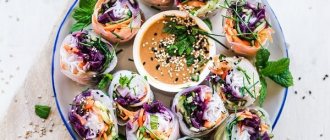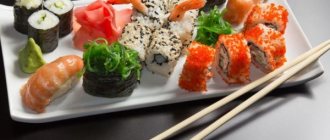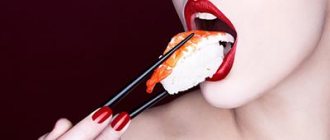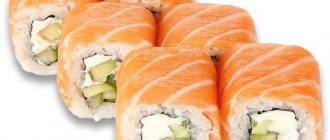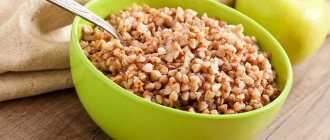- December 21, 2019
- Diets for weight loss
- Elena_Ladypain
When it comes to low-calorie foods, it's hard to beat the Japanese, especially when it comes to sushi. It is not deep-fried or gravy-drenched, and most varieties do not have any added fat. Sushi can also be a great source of omega-3 fatty acids from the fish it's made with. But is it possible to eat rolls on a diet?
Fish, seaweed, rice... Sounds pretty good, doesn't it? According to the survey, 75 percent of nutritionists agreed that sushi is good for health. About 49 percent of the population share the same opinion.
Is it possible to eat rolls and sushi while on a diet? Of course, the actual answer depends on what is contained in them and how much is consumed. This perhaps gives some insight into the reasons for the disagreement. Nutritionists are often optimistic, since few people are able to consume many rolls in one meal. However, there are many possibilities to turn simple raw fish into a dish that contains a lot of unhealthy calories and will lead to overeating.
This can be compared to a salad of leafy greens, to which a lot of toasted croutons have been added. This snack instantly goes from healthy to unhealthy. Likewise, sushi and rolls consisting of unhealthy ingredients cannot be considered part of the diet. Therefore, to understand whether you can eat rolls while on a diet, you need to study a number of important aspects.
What kind of dish is this?
Sushi is often rated as a health food because it contains quite a lot of nutrient-dense components. It is a dish of cooked rice, raw or cooked fish and vegetables. It is usually served with wasabi paste, soy sauce and pink pickled ginger.
Sushi was first prepared in Japan in the 7th century as a way to preserve fish. The purified product was pressed between layers of rice and salt and left to ferment for several weeks, after which the dish was considered ready to eat. Around the middle of the 17th century, vinegar was added to rice to shorten the fermentation period, which improved the taste of sushi.
The fermentation process was stopped in the 19th century, and since then fresh fish have been used. The result was early versions of the ready-to-eat sushi you're used to eating today.
The most common type is nigiri sushi: lumps of sticky rice with a small piece of fish fillet or any seafood. Depending on the type of fish used, the calorie content of one piece varies from 40 calories (scallop, squid) to 50 (yellowtail, salmon) or 65 (eel, sea urchin).
Maki, or rolls, are rolls made from glutinous rice, fish and nori, or dried seaweed. Most rolls are wrapped in nori on the outside, but some have rice on top. On average, one piece of roll has 45 calories. A typical serving of six provides you with between 250 and 375 calories, depending on the type of fish and what's added.
Some rolls contain many more calories than others. For example, the shrimp tempura variety contains about 500 calories in six pieces because the seafood is deep fried. Some types are also made from other seafood, tempura-fried and mixed with cheese or mayonnaise, so they contain much more fat and calories.
Sashimi is slices of raw fish, sliced and served without rice. Most varieties of this dish contain between 30 and 40 calories per 30 gram slice.
To understand whether it is possible to eat sushi on a diet, it is necessary to fully consider its benefits and harms.
What are rolls
Not very thick oblong rolls made from sheets of seaweed (nori is the basis of the snack), inside of which boiled rice, raw sea fish (or other seafood), as well as soft cheese and vegetables are evenly spread, are called rolls. They are rolled using a special bamboo mat, which makes them slightly different from traditional sushi, which is prepared only by hand. Traditional seasonings that give the taste of rice rolls piquant and interesting notes - soy sauce, wasabi green Japanese mustard, pickled ginger.
Fish as the main ingredient
Fish is an excellent source of protein, iodine and numerous minerals and vitamins. In addition, it is one of the few foods that naturally contain vitamin D. Fish also contains omega-3 fats, which your brain and body need to function properly. These compounds help fight health problems such as strokes and heart disease. Eating fish also reduces the risk of some autoimmune diseases, depression and, in old age, vision and memory loss.
Is the sushi diet effective?
Losing weight by eating these exotic dishes will not be difficult if you follow a number of simple rules. The sushi diet is comparable in effectiveness to any other diet aimed at proper nutrition and avoidance of sweets and starchy foods. If you eat only healthy foods, vegetables, fruits, and alternate fish with meat, you can be sure that the kilograms will begin to fall off.
But rolls and sushi themselves do not contain special substances that help burn fat. Therefore, you should not count on rapid weight loss if you adhere to such a diet. But rolls containing few calories can be used as one of the dishes of the selected diet.
Among the advantages of this diet, one can note the improvement in the condition of the skin, hair and nails thanks to the phosphorus contained in fish. Also, Japanese cuisine improves digestion and normalizes the functioning of the thyroid gland.
Wasabi as a main seasoning
This paste is traditionally served with sushi. Since its taste is very strong, this seasoning is used only in small quantities. Wasabi is made from the grated stem of Eutrema japonicum, which belongs to the same plant family as horseradish, cabbage and mustard.
The seasoning is rich in beta-carotene, isothiocyanates and glucosinolates. Research has proven that these compounds can have antibacterial, anticancer and anti-inflammatory properties.
However, due to a shortage of raw materials for preparing wasabi, some restaurants serve an imitation paste made from a combination of mustard powder, horseradish and green coloring. Such a product is unlikely to have similar nutritional properties and qualities.
Seaweed
Nori is a type of seaweed primarily used to make sushi. They contain a ton of nutrients, including magnesium, calcium, phosphorus, sodium, iron, iodine, vitamins C, A and E, and thiamine. In addition, their dry weight consists of 44% protein, the amount of which is comparable to plant protein products such as soybeans.
However, one serving of the rolls contains very little seaweed, making it unlikely that you will meet your daily needs for the above nutrients.
Nori can also provide the body with compounds that fight viruses, inflammation, and even cancer. However, the levels of these substances are probably too low to have any relevant beneficial health effects.
Is it possible to eat rolls and sushi while losing weight?
Anyone who has encountered this traditional Asian dish at least once in their life knows what its main ingredients are. The rolls are boiled rice and sea fish in all its diversity wrapped in nori (a type of seaweed). It could be salmon, tuna, eel. Often added to rolls and seafood: shrimp, squid, crab meat.
There are also vegetable versions of the Asian delicacy with cucumber, avocado, and chukka seaweed. Sushi differs from rolls only in the method of preparation and shape.
Sushi
Pickled ginger
Sweet-spicy pickled ginger, called gari, is often served to cleanse the taste buds when eating various pieces of sushi. It is a good source of magnesium, potassium, manganese and copper.
In addition, ginger may have certain properties that help protect the body from viruses and bacteria. Studies have proven that it can improve memory and relieve nausea, muscle pain, joint pain, menstrual cramps and even LDL cholesterol.
Is this dish suitable for weight loss?
So is it possible to use rolls on a weight loss diet? The protein found in fish promotes weight loss, which is a good start. Salmon, trout and tuna are good options for the diet. However, tuna should not be consumed too often because it contains a lot of mercury. Mackerel, swordfish and yellowtail also contain high amounts of this toxin, so limit them in your diet. Also, avoid imitation crab entirely—it's made from starch and is high in sodium.
What kind of rolls can you eat on a diet? Dietitians say you should avoid unagi sauce (which is a mixture of soy sauce and sugar) and spicy sushi (which is made with mayonnaise mixed with chili paste), as well as most different "creamy" rolls. They add calories and fat to your diet. Even if this isn't a major issue, it's hard to make the case for protein and omega-3s when your serving consists of mayonnaise.
Beware of ingredients such as tempura (or otherwise fried foods) and cream cheese. Besides the fact that they can add extra calories, they tend to crowd out the healthy vegetables and fish in the wrap.
Diet Caesar roll
Do you like Caesar salad? Then you can prepare a Europeanized version of rolls. Since our dish will be dietary, we will use only healthy and correct ingredients.
- Nori sheet.
- Boiled rice. Ideally, it is better to use brown rice.
- Chicken fillet. Rinse, boil in salted water and cut into strips.
- Iceberg lettuce. Cut into strips.
- Tomato. Also cut into strips
- whole grain breads. We will use them for breading! You need to grind them in a blender so that it is convenient to roll the rolls in them.
For the special diet sauce you will need
- 7 tablespoons of natural yogurt + 1 teaspoon of mustard + 1 yolk + pepper + salt. Mix everything or beat in a blender. PP sauce is ready!
To prepare a Caesar roll, you need to use a special mat. Place a layer of rice on a sheet of nori. Now your task is to carefully turn the nori over so that the rice lies on the mat. Fill the outer part of the nori - first lay out a layer of sauce, then chicken, iceberg lettuce and tomato. Very carefully roll up the sheet of nori. Now you need to roll the roll in crushed whole grain bread!
Diet on sushi and rolls
If you're worried about calories, your most important strategy is portion size. Often, sushi and especially rolls are eaten quickly, since no knife is used when eating. Because it takes your brain about 20 minutes to tell you that you're full, eating quickly can lead to overeating.
Reviews of the results of the roll and sushi diet suggest that you can lose about 3-5 kilograms per week. But to lose weight so effectively, you need to set strict limits. Thus, nutritionists recommend that women stick to six pieces of sushi or rolls, and men - nine pieces, which should be eaten with miso soup or seaweed salad. To feel full without overeating, eat slowly and enjoy the taste of the sushi.
When talking about whether you can eat rolls on a diet, you need to consider the following. If your body is prone to fluid retention or you have high blood pressure, be careful with soy sauce. One tablespoon contains 900 to 1,225 milligrams of sodium—almost a daily serving (adults need 1,200 to 1,500 mg of sodium per day). Soy sauce with a reduced content of this trace element contains approximately 600 mg per tablespoon.
Calorie content of rolls
It is impossible to say unambiguously the number of calories in rolls. There are many types of this dish with very different compositions. Let's look at what high-calorie foods can be in rolls:
- White rice. Nutritionists advise avoiding this product when losing weight, because it is very high in carbohydrates. White rice is almost always used in rolls, which can be called the most “dangerous” among all other varieties. There are 80 grams of carbohydrates per 100 grams of this cereal, which is a lot. As for calorie content, 100 grams of white cooked rice will contain approximately 120-130 kcal.
- Philadelphia cheese. This curd cheese itself can be classified as a healthy product, because it has a natural composition, rich in proteins and not burdened with fats. The catch is that manufacturers very rarely take the original Philadelphia and replace it with cheese products that contain a high percentage of artificial and vegetable fats. The original cheese contains about 350 kcal. Other variations of cream cheese may contain many more calories.
- Sauces. Despite the fact that there are not many such supplements, you need to keep in mind that they can be very high in calories. In addition, excess salt in sauces can lead to fluid retention in the body after such a meal.
Refined carbohydrates and low fiber
The predominant component of any sushi is white rice, industrially purified from almost all fiber, minerals and vitamins. A number of studies show that heavy consumption of refined carbohydrates and the subsequent increase in blood sugar promotes inflammation and may increase the risk of heart disease and diabetes.
In addition, sugar is often added to sushi rice. Together with the small amount of fiber, this leads to rapid breakdown of the product in the digestive system. This can sharply increase blood sugar and insulin levels, and cause overeating.
But research also shows that rice vinegar added to sushi can help reduce blood glucose levels, lower blood pressure and lower body fat levels.
Is it possible or not to have rolls on a diet, taking into account the above? Carbohydrates are necessary for the body. To get the maximum benefit and reduce possible harm, it is recommended to eat sushi made from a mixture of white and brown rice. The latter contains fiber necessary for proper nutrition, as well as substances such as vitamin E, zinc, manganese, selenium and magnesium.
You can also make sure the rolls are made with less rice and more vegetables for a significant boost in nutritional content.
Possible harm and contraindications
Only completely healthy people who do not have digestive problems or liver pathologies can adhere to the diet.
Absolute contraindications include:
- metabolic disorders in the body,
- tendency to allergic reactions to the main components of sushi,
- diseases of the chronic course of the gastrointestinal tract (ulcers, gastritis).
The diet is not suitable for pregnant and lactating women, the elderly and children. The diet is poor, and the body stops receiving useful microelements and vitamins for some time. People with disorders of the digestive tract may experience the following disorders when following a diet:
- bowel dysfunction (constipation or diarrhea),
- pain in the epigastric region,
- heartburn,
- sour or bitter belching.
Patients who have previously been diagnosed with liver failure experience severe pain in the right side, attacks of nausea, and the risk of uncontrolled vomiting increases. In rare cases, hypersensitive people who are allergic to fish and seafood experience Quincke's edema.
The dish sometimes contains little protein and a lot of fat
Speaking about whether you can eat rolls on a diet, it is worth noting that they are often considered food for weight loss. However, some varieties contain fatty sauces and are even fried in batter (tempura), which significantly increases their calorie content.
Moreover, one serving of rolls often contains a very small amount of fish or fresh vegetables. It turns out that this food is low in fiber and protein, and, as a result, it is not very effective in satisfying hunger and reducing appetite.
To provide yourself with a healthy lunch and eat rolls while dieting, try adding miso soup, wakame salad or sashimi to them.
Excess salt
Sushi often contains a lot of salt. First of all, the rice used to prepare them is often boiled with salt. Secondly, pickled vegetables and smoked fish also have a lot of this seasoning. Finally, sushi and rolls are traditionally eaten with soy sauce, which contains a huge amount of salt. Abuse of this seasoning can lead to an increased risk of stomach cancer. It also increases blood pressure in people prone to this problem.
So is it possible to eat rolls on a diet to lose weight? To reduce your salt intake and speed up weight loss, you should minimize or avoid soy sauce and avoid sushi containing smoked fish (such as salmon or mackerel). While miso soup can help prevent overeating, it also contains a lot of salt. When you control your consumption of this spice, you should avoid it.
Is it possible to have rolls on diet No. 5? Considering the above, this Japanese dish is not recommended for gastrointestinal diseases.
Menu
You can follow this technique for 3-7 days. Continuing this diet may lead to digestive problems, so don’t tempt fate. You can also have a fasting day with sushi, pampering yourself with delicious food and at the same time getting lightness in your stomach after a long period of eating junk food.
On this diet, you need to consume 1200 kcal per day, so you need to select ingredients for preparing dishes so as to fit within this framework.
If the technique does not last long, then the menu looks like this:
- breakfast – 6 pieces of rolls or sushi;
- lunch – 8 pieces of rolls or sushi;
- dinner – 4 pieces of rolls or sushi.
You can have snacks between main meals if you have a strong feeling of hunger. For example, you can eat 1 apple or a small portion of low-fat cottage cheese. In addition to this, you need to drink a lot of water (at least 1.5 liters per day) and, if desired, green tea.
If you plan to stretch the diet for more than 3 days, then the menu should be varied.
An approximate weekly diet looks like this:
- Day 1 – Japanese omelette for breakfast, 8 pieces of rolls with any filling for lunch, Japanese salad for dinner;
- Day 2 – for breakfast 2-3 apples, oranges or grapefruit, green tea, for lunch miso soup, seaweed salad, for dinner 4-5 pieces of rolls or sushi with boiled fish;
- Day 3 – Japanese salad and 1 apple for breakfast, oyakodon (Japanese omelette) with chicken for lunch, low-fat cottage cheese with apple or grapefruit for dinner;
- Day 4 – low-fat cottage cheese with kiwi for breakfast, 8 pieces of rolls with any filling for lunch, buckwheat noodles with vegetables and squid for dinner;
- Day 5 – Japanese omelet and Japanese salad for breakfast, miso soup for lunch, 4-5 pieces of rolls with any filling for dinner;
- Day 6 – Japanese salad and 1 apple or 2 kiwi for breakfast, 8 pieces of rolls with any filling for lunch, sashimi (fish with a special sauce) for dinner;
- Day 7 – 2 apples and green tea for breakfast, miso soup for lunch, 4 sushi with salmon for dinner.
Important: You should eat all Japanese dishes with traditional chopsticks, and not with a fork or spoon.
It is not in vain that the wise Japanese use this particular device for meals, because this way they can enjoy the food and chew it well without fuss. In this case, satiety will come much faster, and gradually you will get used to eating less.
Infection with parasites and bacteria
Eating sushi made from raw fish can increase the risk of infection by various parasites and microorganisms. Some of the species most commonly found in this dish include Salmonella, various Vibrio bacteria, and the parasites Anisakis and Diphyllobothrium.
It is important to note that regulatory authorities do not currently regulate the use of the "sushi fish" label. Therefore, this label does not guarantee that the food you eat is safe.
The only rule that works is that some types of fish should be frozen to kill parasites and only then served raw.
Some, including pregnant women, young children, the elderly and people with weakened immune systems, may need to avoid sushi made with raw fish entirely.
Mercury and other toxins
Fish may also contain heavy metals such as mercury due to ocean pollution. Predatory species such as tuna, swordfish, mackerel, marlin and shark tend to have the highest levels of this dangerous metal. Is it possible to eat rolls while dieting and avoid poisoning? A list of low-mercury seafood includes salmon, eel, sea urchin, trout, crab and octopus. These products are dietary.
Other types of toxins found in fish can lead to ciguatera or scomboid poisoning. Sea bass and red snapper are the most likely sources of ciguatera poisoning, while the latter poison is most often caused by eating tuna or mackerel. You can reduce this risk by avoiding fish species that may be contaminated.
How to Maximize the Health Benefits of Sushi
So, to the question of whether it is possible to eat sushi on a diet, experts give an affirmative answer. To get maximum health benefits and lose weight, follow these guidelines:
- Increase your nutrient intake with this dish. Choose sushi and rolls with brown rice instead of white.
- Prefer cone-shaped rolls (temaki), which contain less rice than traditional rolls.
- Try to increase the fiber and protein content of your servings. Pair each serving of sushi with wakame salad, miso soup or sashimi.
- If the answer is yes to the question of whether you can eat rolls on a diet, you must adhere to the following rule. Avoid varieties with cream cheese, mayonnaise, rich sauces or tempura. To make your roll crispy or juicy without these unhealthy ingredients, add extra vegetables.
- Reduce the amount of soy sauce. If you have a sensitivity to salt, avoid it or just lightly dip your sushi in it, one edge at a time.
- Order from reputable restaurants that are likely to follow food safety guidelines.
Which sushi to choose on a diet?
As we have already found out, you need to approach the choice of rolls with special care - they can vary greatly in their calorie content. And there are so many varieties of this dish! First, let's figure out which of them will definitely not be useful for our figure.
Rolls with high-calorie filling. Sushi filled with bacon, cream/curd cheese, or especially mayonnaise is absolutely not suitable for the diet. In such a dish the amount of fats, including hydrogenated ones, increases sharply. Therefore, the ban also includes the very popular Philadelphia and California rolls, which contain sushi cheese.
Rolls with smoked or salted filling. They don't have many calories, but such products disrupt the water-salt balance and cause swelling. Which results in weight gain.
Breaded rolls. Tempura is a method of preparing rolls in which they are breaded and fried. These rolls have an attractive crispy crust, which contains a lot of extra calories. And also fat, since the tempura roll is prepared in a large amount of oil.
Rolls with eel. The calorie content of eel exceeds 330 kcal per 100 g! It also contains over 30g of fat. Give preference to other types of fish - salmon, tuna.
Vegetable rolls. It would seem that ordinary poppies with cucumber contain a very small amount of calories. And this is true, but at the same time they completely lack protein. As a result, only carbohydrates remain in the roll - polished rice, vegetables. Carbohydrates are not as satiating as proteins and fats (which are found in fish rolls), so you will soon want to eat again.
Which ones should you choose then? It's simple! When following a diet, choose rolls or sushi that combine fresh fish/seafood and vegetables. Of course, they should not contain all the ingredients listed above - sauces, mayonnaise, breading, etc. You also need to give up eels. If you make rolls at home, use brown rice.
Interesting: Is it possible to lose weight if you don’t eat after 6?
And finally, let’s visually analyze how the calorie content per 100 g of sushi and rolls increases when other ingredients are added to them:
- maki with cucumber – 70 calories;
- Mashiro Daikon roll (nori, white rice, salmon, tuna, cucumber) – 72 calories;
- sushi Nigiri (rice, salmon, strip of nori) – 96 calories;
- Tuna maki (nori, rice, tuna) – 106 calories;
- Philadelphia roll (rice, nori, cream cheese, plenty of salmon, cucumber/avocado) – 152 calories;
- California roll (rice, nori, cream cheese, fish, capelin caviar/sesame for sprinkling) – 180 calories;
- baked roll with breaded eel – 300 calories.
